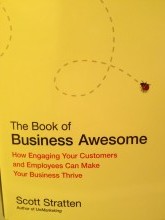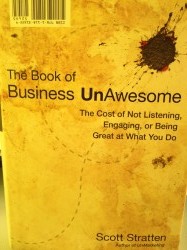 If you’ve ever seen Scott Stratten (@unmarketing) speak you know that he offers a great mix of information, anecdotes, and comedy. When I picked up his new book “The Book of Business Awesome & UnAwesome” I was pleased to see that these traits carried over into his writing as well.
If you’ve ever seen Scott Stratten (@unmarketing) speak you know that he offers a great mix of information, anecdotes, and comedy. When I picked up his new book “The Book of Business Awesome & UnAwesome” I was pleased to see that these traits carried over into his writing as well.
Scott’s new book is very cleverly compiled. If you flip the book one way, you’ll find a collection of stories and experiences of businesses that are taking an “Awesome” approach to engaging customers in a meaningful way. On the flipside, you will find companies taking an “UnAwesome” approach that leaves customers wanting more. If you’re in the market for a new business boo, pick up “The Book of Business Awesome & UnAwesome”. It’s easy to read and contains many great nuggets of useful information.
The Book of Business Awesome
 Companies Aren’t Awesome; People Are
Companies Aren’t Awesome; People Are
As one of the opening pages to the Awesome side, this chapter provides some much needed advice to marketers and business professionals. Scott shares “Too often, feeling intimidated becomes our excuse not to be awesome.” This book is meant to inspire readers to find their own way of being awesome, and rely on that special something they can bring to the table.
Another step to awesomeness is realizing that each role within your company has it’s own opportunities and is very important. When people come together to work on a project it’s potential to be awesome is that much greater.
Remarry Your Current Customers
As marketers we often get caught up in the thrill of seeking and engaging new customers. That said, did you know that it costs more money to acquire new customers than to keep your current ones? Once we’ve worked with a client for an extended period of time we may begin to take them for granted. Customers who experience poor service may begin searching for another company to court them. How can you keep your clients from wandering? Hire great Account Managers or Customer Service representatives, run an ongoing training program, and create a culture of value.
PR Stands for People React
Social Media has created a unique set of challenges and opportunities for those in Public Relations. Instead of the more traditional “get the word out” approach, PR has had to focus more on getting the word back in and managing their online engagement.
The power of great stories when positive is what Scott calls “Brand Magic”. However, when the messages are negative it can be a disaster. According to Scott there are three things that can make the different between a PR fail and a PR success.
- Timing
- Accountability
- Appropriate Personality
The Book of Business UnAwesome
 How to Flip Off Your Customers
How to Flip Off Your Customers
Many companies start down the path of making themselves available to handle customer service related issues and then drop the ball, hard. In this chapter Scott shares an example of a bad experience he had as a passenger on a train. The attendant was very rude and made the trip unpleasant. Scott decided to take to the Twittersphere and was pleased to find out that he got an instant response. The problem? It was an automated response and took the company over 10 days to actually respond to his inquiry.
Another example would be if you (and I hope you do) have a contact form on your website. Once someone has completed the form, how long does it typically take your team to respond? If it’s more than 24 hours, it’s time to step it up. He who responds first (and has the best solution), wins the business.
What Is the ROI of a Pin?
Pinterest exploded as a social site because the users became “rabid fans”. Pinterest is an example of a website fueled by the users passion. Attempting to force your brand and marketing message onto a site in the wrong way, can kill the passion of the users. Once users begin to feel like they are bombarded with ads instead of awesomeness, they’re likely to retreat. This sort of strategy can dilute the great content on the platform, making it even harder to connect to and engage actual users.
TopRank Readers Bonus: Q&A with Scott Stratten
Question #1: What are three things marketers can do TODAY to begin moving down the path to being Awesome?
- Realize that marketing is a verb, it’s what we do. It’s not a title.
- Branding has nothing to do with us. A brand is the public’s perception of us. You don’t make the brand statement, they do.
- HR is part of marketing. The best marketing happens at the front lines. Hire the wrong people, and it can hurt any product/service.
Question #2: What do you think is the biggest excuse marketers often use for being UnAwesome?
That there is no “ROI” in it. But if they believe that word of mouth or “going viral” has ROI, that’s what being awesome is. It’s also about control. Awesome nowadays includes the public running with the story and possibly engagement. We don’t control the story, and that scares some marketers.
Question #3: I really enjoyed your chapter on remarrying your current customers. What are some tips for engaging our current customers long after the thrill of courtship is over?
Ask them a question with three words: Stop, Start, Continue. What should we stop, start and continue you doing to ensure we’ll be part of your world for years to come. And then listen to the answers. Reply to them on Twitter. If they tweet they love your brand, thank them. If they’re upset, apologize. We just want to know we’re being listened to. Luckily, brands are terrible at this so it’s an easy bar to reach.
Question #4: One of the UnAwesome sins that many marketers are guilty of is making their customers wait for a response. What does it cost companies NOT to respond quickly?
The problem is, especially when it hits the fan, is the story spreads so quickly. If you delay in responding, your eventual response will never catch-up to the initial outrage. Outrage doesn’t take the weekend off and waiting a week to reply equals years in an online lifespan. When it hits the fan, it’s not time to hid behind the fan, it’s time to be awesome. Oh, and never anger geeks. Or moms. Or geek moms. They’ll mess you up.
Can’t get enough of Scott Stratten? Take a look at his YouTube Channel, it’ll keep you informed and entertained for hours: http://tprk.us/Porp9h


